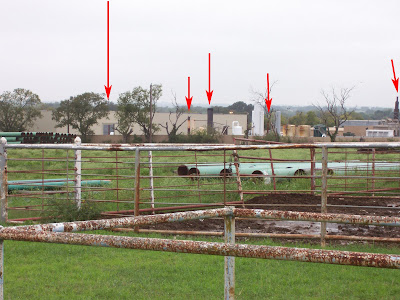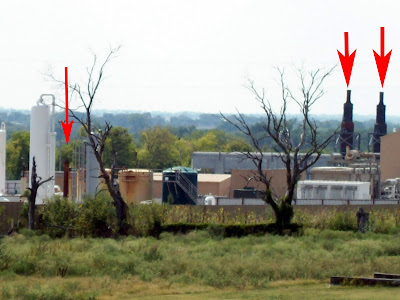I almost forgot about the FLIR GasFinder infrared camera demo we had in DISH, TX on Monday. Mayor Tillman, Wilma Subra, Alisa Rich and I were treated to a demo by Craig R. O’Neill, Sr. District Sales Manager – N. Texas, Arkansas, & Oklahoma. I seriously need one of these magic cameras that makes the invisible visible! A girl’s best friends–a FLIR camera and a Geiger counter.
The pictures below are marked with red arrows where we saw the “black smoke” boiling out into the air. (We were not allowed to keep any of the data from the camera.)
The arrow tail length indicates the level of emissions. (click to enlarge)


Today, the NY Times has an article about seeing unseen methane leaks with an infrared camera.
By Degrees
Capturing the Benefits of Catching Escaping Methane
…three black plumes of gas gushed through leaks that were otherwise invisible.
“Holy smoke, it’s blowing like mad,” said Mr. Gosney, an environmental field coordinator for EnCana, the Canadian gas producer that operates the year-old well near Franklin, Tex. “It does look nasty.”
And here’s a quote from Dr. Al:
“This for me is an absolute no-brainer, even more so than putting in those compact fluorescent bulbs in your house,” said Al Armendariz, an engineer at Southern Methodist University who studies pollutants from oil and gas fields.
(I got to meet Dr. Al Monday night in DISH.)
This is an important article that describes a serious problem with the “bridge fuel.”
Internationally, the amount of methane escaping from gas and oil operations can be only crudely gauged. But in 2006 the E.P.A. estimated that Russia, the world’s largest gas producer, ranked highest, with 427 billion cubic feet of methane escaping annually, followed by the United States at 346 billion, Ukraine at 225 billion and Mexico at 191 billion.
But the EPA estimates that the figure is much higher:
In its analysis, the E.P.A. concluded that the amount emitted by routine operations at gas wells — not including leaks like those seen near Franklin — is 12 times the agency’s longtime estimate of nine billion cubic feet. In heat-trapping potential, that new estimate equals the carbon dioxide emitted annually by eight million cars.
In case you haven’t seen it watch this video where a FLIR infrared video camera let’s you see what can’t be seen.
UPDATE: For more IR videos see:
Marathon Sugarhorn facility in Eagle Ford Shale
Barnett Shale: TCEQ Videos Show Fugitive Emissions and TCEQ videos show VOC emissions in Eagle Ford Shale
TXsharon’s YouTube Channel – the YouTube videos industry loves to hate.
ArubaGreed’s YouTube Channel A stunning collection of videos by Tim and Christine Ruggiero, landowners on top of the Barnett Shale.
Dr. Colborn and TCEQ comment on what you see with the TCEQ infrared technology cameras in videos above.
About Sharon Wilson
Sharon Wilson is considered a leading citizen expert on the impacts of shale oil and gas extraction. She is the go-to person whether it’s top EPA officials from D.C., national and international news networks, or residents facing the shock of eminent domain and the devastating environmental effects of natural gas development in their backyards.
- Web |
- More Posts(5121)
Damn, that is an enlightening article in the Times. Makes me think that gas drilling is the #1 culprit in causing global warming. All that methane that was safely underground is now in the atmosphere.
I think the bridge just collapsed!
Wasn't there a report on cattle producing methane in large amounts.
Please teach me something.I though FLIR only works off temperature.I didn't know it can also tell you chemical makeup.
The American Cattle Producers has taken steps to reduce methane production in cattle. They discovered that changing the feed slightly reduces methane production dramatically.
So, what has your industry done other than release methane into the atmosphere?
The camera is a FLIR GasFind IR camera. The infrared gas-imaging camera used by Leak Surveys, Inc., consists of a modified Indigo (FLIR/Indigo Systems Corp., Goleta CA) Merlin MID camera with a nominal spectra range of 1- 5.4 micrometers.
The spectral range is limited with the use of a notch filter specifically designed for the detection of hydrocarbon infrared adsorptions in the 3-micron region. The narrow bandpass range of the filter is less than the infrared spectral adsorption of gas phase hexane. The filter notch is positioned such that alkane gases have a significant response within the bandpass range.